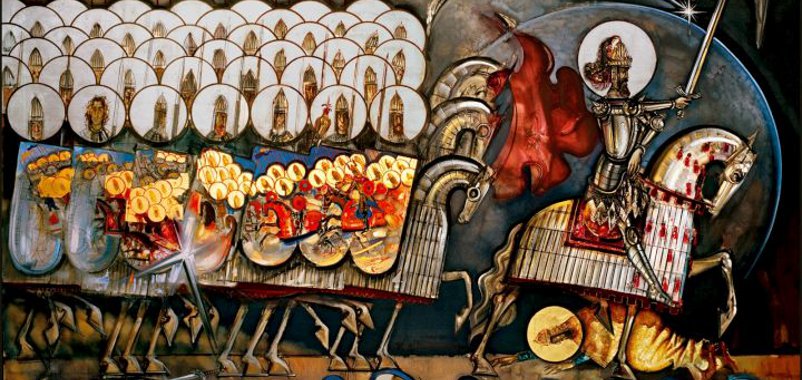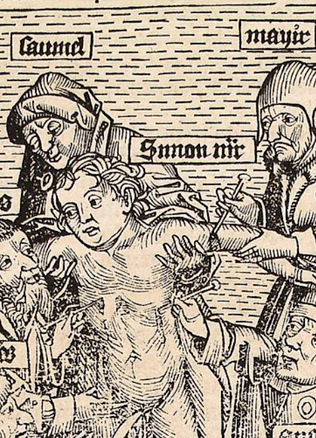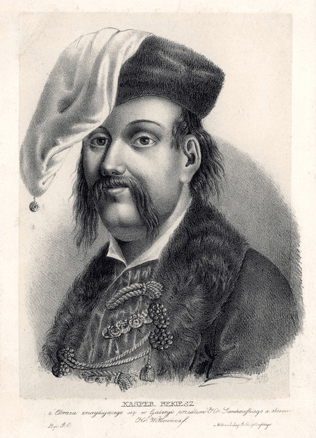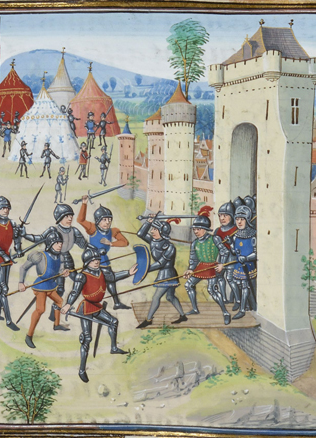The Battle of Blue Waters
The mythological understanding of the world that is characteristic of our present-day society is most vividly expressed in our discussions about the distant past. One kernel of this contemporary mythology is the lofty speeches and projects initiated by important figures that are devoted to the anniversary of the Battle of Blue Waters (1362-2012). According to enthusiasts, the Battle of Blue Waters was a remarkable victory of Lithuanian and Ukrainian might against the Tatars. Having defeated the powerful army of the Golden Horde, Algirdas joined a wide swath of what today is Ukraine to his country. It is said that thanks to this victory, the Grand Duchy of Lithuania was able to be established, with the development of Ukraine turning toward the West. It would be wonderful if this image would at least somewhat fit the historical reality of the 14th century.
A shared enemy encourages friendship
However, Lithuanians did not fight and liberate lands of the Rus’ from the yoke of the Tatars. There were no direct battles of a broader scale either in the 13th century or in the second half of the 14th century. The first large-scale battles against the Tatars occurred only in the times of Vytautas, when the Crimea was reached in 1397-1398. This successful start ended with a painful loss at the Battle of the Vorskla River (1399). It was only after a good decade that Vytautas could once again more actively influence Tatar affairs.
One cannot describe the relations of both Gediminas and Algirdas with the Tatars either as friendly or unfriendly. A certain balance of power between the forest Lithuanians and steppe Tatars was influenced by the fact that the Lithuanians avoided open confrontation with the Golden Horde, while the Tatars strove to stop Lithuanian rule from becoming too strong in Ruthenian lands. Most often disagreements between them were provoked either by the resistance of Ruthenian dukes against Lithuanian expansion, or disagreements between Ruthenian dukes that had chosen a pro-Lithuanian policy and those who chose a pro-Tatar one. These conflicts ended with the fact that the Ukrainian lands that were joined to Lithuania in the 14th century continued to pay tributes to the Tatars. The double dependence of these lands on the Lithuanians and the Tatars is described as a condominium, or political territory shared by two or more sovereign states.
With such relations, it comes as no surprise that the Lithuanians and Tatars not only had confrontations, but also worked together. For example, after the death of Duke Yuri II of the Kingdom of Galicia-Volhynia (1340), the efforts were renewed by Polish King Casimir III to gain a foothold in these lands. The Polish expansion that begun brought the Lithuanians and Tatars together, which is why there were cases when Lithuanian and Tatar soldiers together would raid Polish lands (1341 and 1352). These joint actions show that there was a common interest to plunder foreign lands. Though one can find opinions which accentuate the hostile and conflictual nature of Tatar-Lithuanian relations in historiography, their coexistence was based on pragmatic calculations.
Do You Know?
Though one can find opinions in historiography that accentuate the hostile nature of Tatar-Lithuanian relations in the 14th century, Ukrainian historian Olena Rusina claims that at that time, the relations between Lithuanians and Mamai-controlled Tatars were based not on confrontation, but on an agreement between themselves. It was precisely this Lithuanian-Tatar cooperation that became an important factor that allowed Algirdas to gain power in the broad territories of Podolia, Kiev, Chernigov, and Bryansk.
A battle for civilization or routine plundering?
In speaking about the Battle of Blue Waters, one should note that the first accounts of Algirdas’ victorious fight against the Tatars appeared only in later and unreliable 16th century sources.
For the Lithuanian Chronicles, the story about Algirdas’ victorious fight against the Tatars served as an argument for the right of the GDL to the lands of Podolia, which Poland also laid claim to.
The “invention” of the Battle of Blue Waters that was characteristic of the Lithuanian Chronicles went hand-in-hand with the legendary stories about the Lithuanians’ battles against the Tatars. It was only between the end of the 15th century and beginning of the 16th century that a need appeared for stories about the Lithuanians’ “right of the sword” in conquered Ruthenian lands. It was propaganda directed against the rhetoric of Moscow, which had liberated itself from Tatar control and laid claims to all lands of the Rus’.
So, what happened in 1362? The Rogozh Chronicle, which preserved the early tradition of the Tver Chronicles, provides a particularly brief note: “That same year the Lithuanians occupied Korshev, rebellions arose around the entire land as well as great strife for the people. That same fall Algirdas laid waste to Blue Waters and the White Shore.”
Not only does this record fail to mention the Tatars, but it also does not mention a battle. It most likely was a typical, large-scale invasion for plundering, during which the town of Blue Waters, located near the Blue Waters River (today the Sinyucha River), was destroyed, along with the area called Blue Waters on the right side of the Dniepr River south of Kiev. Algirdas’ raid was most likely influenced by the need to reconsolidate Lithuanian rule in Kiev after the death of Gediminas’ brother Theodor (1362). Local inhabitants suffered during this raid and perhaps one or another skirmish occurred with the nomadic Tatar generals wandering there, but it is doubtful one could consider it as an action directed against Tatar rule.
The raid that went toward the Blue Waters River occurred at a time the Golden Horde had been enveloped in a political crisis that had lasted for two decades after the death of Khan Berdibek in 1359. In the 1460s the military commander Mamai rose to power, who controlled the Tatar hordes that wandered on the right side of the Volga River in the steppes. Ukrainian historian Olena Rusina claims that at the time the relations of the Lithuanians and Mamai-controlled Tatars were based not on confrontation, but on an agreement between them. It was precisely this Lithuanian-Tatar cooperation that became an important factor that allowed Algirdas to gain power in the broad territories of Podolia, Kiev, Chernigov, and Bryansk. The Lithuanian and Tatar condominium continued its existence. If we want to consider the disintegration of this political model as Ukraine’s turn toward Western civilisation, this only happened during the times of Vytautas. At the end of the 14th century Khan Tokhtamysh, who was looking for support from Vytautas, “allowed” Vytautas and his successors to rule lands of the Rus’ and refused to demand tributes from them.
Literature: D. Baronas, A. Dubonis, R. Petrauskas, Lietuvos istorija, t. 3: XIII a. – 1385 m. Valstybės iškilimas tarp Rytų ir Vakarų, Vilnius: Baltos lankos, 2011.
Darius Baronas




